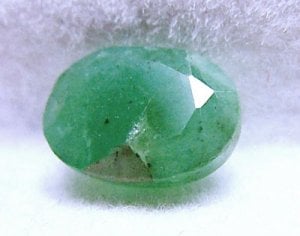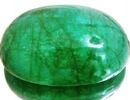- Joined
- Jul 15, 2009
- Messages
- 356
Hello All;
I was browsing around on the favorite auction site and was looking for a semi mount; the company which is thought of very highly here had an emerald of 2+ carats in the mount and it looked very nice and vibrant. But the seller did not state any treatment, natural, etc. so of course I asked.
This is their return statement. The emerald is of Colombian origin; but it is neither 100 percent natural nor 100 percent synthetic; it is re-created rough from Colombian Emerald.
Wow what are they doing; would someone like Morecarats, etc. who are in the loop shed some light on this new treatment they are doing to emerald, I know of excel, oiling, dying, fracture filling, and of course the normal hydrothermal, etc. synthetics; but are they now reconstituting emerald like quartz and ruby???
Many thanks; I am glad the seller is honest in the return emails as I too have bought semi mounts from them and was happy for the price; but it would have been nice if they had listed that treatment in the original selling post on the site.
I know many years ago when I was selling only to the trade a lady wanted a natural pink sapphire; I sent one on memo to the jeweler; the lady went across the mall and saw one for 1/3th the price; and wanted to know why so much difference; I asked the lady to ask the other jeweler if the sapphire was natural. It was not it was synthetic. The jeweler did not advertise the sapphires were man made; how many people are duped by not asking if a gem is natural???
I just can not understand why not disclose everything you know; everyone can make a mistake but to me that seems a little deceptive???
Just my opinion; but I would like to know what other gem minerals are getting reconstituted; I guess if it has a 100 per carat value or greater it falls into that category to be cooked???
Most respectfully;
I was browsing around on the favorite auction site and was looking for a semi mount; the company which is thought of very highly here had an emerald of 2+ carats in the mount and it looked very nice and vibrant. But the seller did not state any treatment, natural, etc. so of course I asked.
This is their return statement. The emerald is of Colombian origin; but it is neither 100 percent natural nor 100 percent synthetic; it is re-created rough from Colombian Emerald.
Wow what are they doing; would someone like Morecarats, etc. who are in the loop shed some light on this new treatment they are doing to emerald, I know of excel, oiling, dying, fracture filling, and of course the normal hydrothermal, etc. synthetics; but are they now reconstituting emerald like quartz and ruby???
Many thanks; I am glad the seller is honest in the return emails as I too have bought semi mounts from them and was happy for the price; but it would have been nice if they had listed that treatment in the original selling post on the site.
I know many years ago when I was selling only to the trade a lady wanted a natural pink sapphire; I sent one on memo to the jeweler; the lady went across the mall and saw one for 1/3th the price; and wanted to know why so much difference; I asked the lady to ask the other jeweler if the sapphire was natural. It was not it was synthetic. The jeweler did not advertise the sapphires were man made; how many people are duped by not asking if a gem is natural???
I just can not understand why not disclose everything you know; everyone can make a mistake but to me that seems a little deceptive???
Just my opinion; but I would like to know what other gem minerals are getting reconstituted; I guess if it has a 100 per carat value or greater it falls into that category to be cooked???
Most respectfully;










300x240.png)